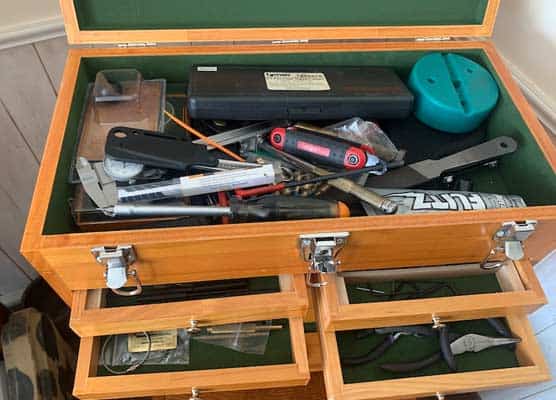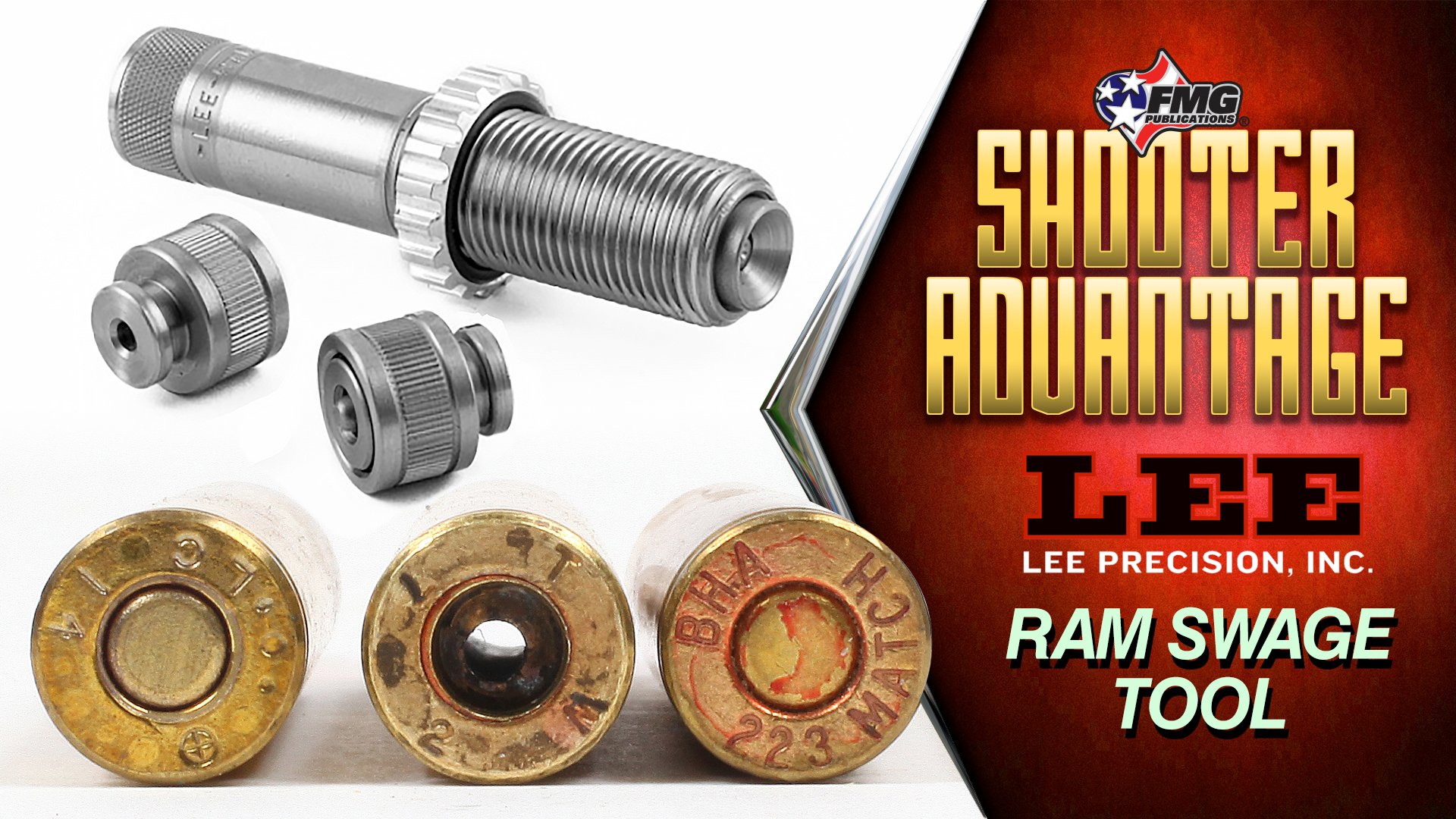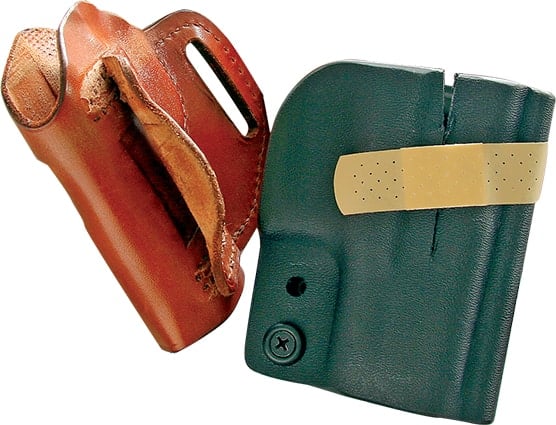Ayoob Files: Murder or
Self-Defense?
Situation: The big man who just threatened to kill your mother appears about to do so. You have a weapon in your hand …
Lesson: You don’t have to be right; you have to be reasonable and seen as such in criminal court, civil court and the court of public opinion.
It is the evening of Good Friday, but this particular Friday won’t be good for any of the three people in this tableau. We have the 6′ abusive boyfriend, the petite now-single mom, and her slender, pubescent daughter.
Boyfriend and mom are screaming at each other in the master bedroom. She is shouting to him their relationship is over. He is raving that she’ll never leave him. He’ll disfigure her. Then, his rage turns homicidal. Disfigure? No, he’ll kill her, he yells obscenely, and her mother and her daughter! The daughter, outside the bedroom door, has been listening to all of this. She has armed herself with a knife from the kitchen drawer.
Suddenly, the door opens. The young girl sees her tiny mom coming toward her, followed closely by the boyfriend who towers over her. He has something in his hand — and now he raises that hand!
The girl steps forward.
Even though it is held clumsily with the edge up, the 8″ blade of the carving knife pierces the man’s upper abdomen. Its sharp point finds the liver, the portal vein between it and the intestines, and the aorta.
The man’s eyes widen as he utters his last words: “My God, Cheryl, what have you done?”
He begins to turn away, then topples backward, sprawling with his arms outstretched.
Self-defense or murder? Not just the law, but the world will decide.
Details
The date is April 4, 1958. The place is a mansion on North Bedford Drive in Beverly Hills, Calif. The dead man has gone by many names, but his real one is John Stompanato. The young girl who brought the carving knife from the kitchen to protect her mother is Cheryl Crane, age 14, and her mother is one of the world’s most beloved actresses, fresh from an Academy Award nomination, Lana Turner.
It’s not just a homicide: Because of who it involves, it’s now a “scandal” that occupies headlines throughout the nation and even the world.
The police were not summoned, but instead the family doctor, who was horrified at what he found. Finding no pulse, he injected epinephrine into Stompanato’s heart, but to no avail. He turned to Turner and said, “Call Jerry Giesler.”
Giesler was Hollywood’s “lawyer to the stars.” He represented Charlie Chaplin, Errol Flynn, Marilyn Monroe and numerous other Tinseltown celebrities. He also represented famed lawyer Clarence Darrow and, on the other end of the spectrum, mobster Bugsy Siegel.
By the time someone finally called the police — some two hours after the stabbing — Giesler was already at the death scene, along with Fred Otash, the “private investigator to the stars” in Hollywood. The Beverly Hills Police Chief came to the scene himself, of course, and was furious to find the attorney and the private eye there ahead of him. He may also have been somewhat chagrined: A week before, Lana Turner’s mother had talked to him about Stompanato beating her daughter, and he had told her Lana had to make a report to the police department. Fearing a scandal, Turner had not done so.
Clinton Anderson had the longest tenure as Chief in the department’s history — 26 years from 1942 to 1969 — which means he had to know how to navigate political and public opinion waters. He, and for that matter, the prosecutor, knew that in such a high-profile case, they could not be seen as showing favoritism to Hollywood royalty.
Cheryl Crane did not go home that night. She was kept in custody supposedly as a material witness but also under suspicion of murder. The girl who had acted to save her mother’s life was in the mouth of the justice machine.
The Criminal Justice Side
A Coroner’s Jury, somewhat similar to a Grand Jury, was convened. On the advice of attorney Giesler, Cheryl did not testify. The prosecution does not seem to have objected too strenuously to that: She had already given the police a complete statement in which she made it clear the knife was in her hand when it entered Stompanato’s body. The star witness was a conservatively dressed, perfectly coiffed, and stunningly beautiful 37-year-old Lana Turner.
By all witness accounts, she was also stunningly articulate. Her critics said she was acting and that it was the best performance of her career. Even if that criticism was on point, it didn’t necessarily mean she was falsifying her testimony. Turner was an A-list actor at the top of her profession. A doctor will testify like a doctor, a lawyer will sound like a lawyer on the witness stand, and no one should have been surprised that Lana Turner sounded like an actor.
The Coroner’s Jury didn’t take long to return a verdict of Justifiable Homicide.
There would be no charges, no trial. But it is said, “You can beat the charge, but you can’t beat the ride.” Cheryl Crane was declared a ward of the state and remained such for some time, eventually going into the custody of her grandmother. Obviously traumatized, her later teen years would include time as a runaway and also a suicide attempt.
Civil Court Side
Relatives of John Stompanato sued Lana Turner, demanding three-quarters of a million dollars. In 1962, the case was settled for $20,000, which, according to one analyst, would be 200 grand or more in today’s dollars. For a wealthy Hollywood star, it was a “drop in the bucket,” according to one commentator. Most “in the know” considered it a “nuisance settlement” for “chump change.”
Court Of Public Opinion
The Court of Public Opinion convened the day after the incident, fueled vigorously by the press, and remains in session to this day, 66 years later.
Gossip-mongers made much of the fact that the Lana/Johnny relationship wasn’t the first rodeo for either of them. Ms. Turner was married eight times over her years to seven husbands, having once remarried Cheryl’s father, Stephen Crane, and had been romantically linked at various times with Ronald Reagan, Robert Stack, George Montgomery, Robert Taylor, Frank Sinatra, Tyrone Power and other famous stars. Her friends called her a hopeless romantic.
The public, for the most part, only knew that Stompanato was a shadowy figure with disreputable associates. People who knew him, including the police, knew more. Stompanato was a WWII vet, a Marine who had fought in the Pacific Theater. There wasn’t much else good to say about him. Thirty-two years of age at the time of death, he had already been through three marriages himself with a history of abandoning his wife and child. He had been the bodyguard/chauffeur of Mickey Cohen, the notorious Los Angeles mob boss. Cohen, in turn, had begun his criminal career as a bodyguard for Chicago mobster Joe Barron. The day had come when a trio of rival gangsters opened fire on Barron and Cohen shot back and killed two of them. That shooting had been ruled justifiable in self-defense. Does anyone think a gangster with that life experience would let Stompanato guard his body without a gun?
Stompanato had a reputation as a skillful, well-endowed lover and gigolo who sought out stars and starlets alike, seduced them, leeched off the rich ones and took incriminating pictures of them for subsequent extortion. After his death, he was reportedly found to have been in possession of nude photos he had taken of Turner when she was asleep. His history of brutal physical violence against Turner herself is something we’ll get to shortly.
The scandal Lana Turner had feared when she hesitated to make formal complaints against Stompanato for brutalizing her flamed up to something far worse after the killing. Though Turner had been certain her film career would die with Stompanato, she remained in demand. Indeed, her most recent movie, which was in theaters at the time of the incident, reportedly enjoyed a 20% uptick in ticket sales after the headlines hit. Ms. Turner stayed busy, on screen, and wealthy until her death from throat cancer in 1995 at the age of 74.
Cheryl Crane had taken control of her life by the time she was 21, working as a popular hostess at her father’s restaurant. She went on to a successful career in real estate, and today is retired and living happily with her wife and lifelong significant other, former model Jocelyn LeRoy. But the controversy goes on as you read this. As evidence, I offer the 2024 publication of Casey Sherman’s book A Murder in Hollywood: The Untold Story Of Tinseltown’s Most Shocking Crime.
“Murder?” Really? After an official finding of Justifiable Homicide? Let’s look at some of the fine points of the matter.
Analysis
What justifies homicide is a situation of immediate, otherwise unavoidable danger of death or great bodily harm to oneself or an innocent party one has the right to protect. It is determined by the simultaneous presence of three criteria, most commonly known as AOJ: Ability, Opportunity and Jeopardy. Ability means the opponent has the power to kill or inflict crippling injury. Opportunity means he is capable of doing so immediately. Jeopardy means the opponent is manifesting an intent, by words and or actions, to kill or cripple someone he had no right to harm.
Ability? While Cheryl Crane saw something in his raised hand that she thought was a weapon, it turned out to be wooden clothes hangers with garments he was carrying away because Turner had just kicked him out, but Crane had no way of knowing that in a brief, tension-fraught moment. Johnny’s threat to cut Lana’s face could certainly be probable cause to believe he had immediate access to an edged weapon.
In addition to weapons, the ability factor can also be constituted by disparity of force: The ostensibly unarmed assailant is physically capable of killing or crippling the intended victim. One element of such is size and strength: Stompanato was a muscular six-footer while Turner stood only 5’3″ (and Crane, while 5’9″, was slender and much lighter than Stompanato). Check. Male versus female is usually another disparity of force element: Check. The ability factor was absolutely there.
Opportunity, the immediacy element? Stompanato was right behind Turner, his arm upraised as if to wield whatever was in his hand as a weapon, and Crane but a single step away. Check.
Jeopardy, the manifest intent element? Crane, listening fearfully outside her mother’s bedroom door, had heard the escalating threats that Stompanato had screamed into Turner’s face. Another check mark.
The yardstick for all of this is what has been called the Doctrine of the Reasonable Man and is better called the Doctrine of the Reasonable and Prudent Person. The judge can be expected to instruct the jury in both criminal and civil cases to ask themselves, “What would a reasonable and prudent person have done in the exact same situation, knowing what the defendant knew at the time?” Let’s analyze that three-pronged test.
Exact same situation: The young daughter is aware this man has brutalized her mother before and has heard him scream threats to cut her face so badly that no man will ever want to look at her again, and then escalate to threats to kill her and her family. Cheryl has become so alarmed she has gone downstairs to take a carving knife from the kitchen in case she needs to protect her mom. As the door opens, she sees the “threatener” behind the mother, whose back is to him, raising a hand that holds something, and she believes if she does not act now, her mother may die in front of her in an instant.
Knowing what the user of force knew: Cheryl Crane had seen her mother’s bruises and black eyes in the past that she knew had been inflicted by Stompanato. On one occasion, he had strangled her mother so viciously she was unable to speak her lines for three weeks. Another time, when Turner was filming in London, pictures appeared in the newspaper of her with co-star Sean Connery implying a romantic relationship, and the violently jealous Stompanato had flown to London with a revolver, shown up on the movie set, and waved the gun around with obvious indication of being prepared to use it. Connery, who had been a bouncer in his younger days, had twisted Stompanato’s wrist until he dropped the gun and then, by most accounts, knocked him down with a single punch.
It was a matter of record that the illegal gun charge got Johnny deported from England with a couple of Scotland Yard detectives accompanying him to the plane to make sure he left. The revolver he brandished there would have wound up in the custody of London Metropolitan Police, but he was known to own other firearms. According to one report, a box in which he was known to keep a revolver and incriminating extortion materials disappeared after his death, and a couple of .32 automatics were found in his crash pad. After his death, a handgun registered in his name was connected to a separate homicide. (The latter, of course, would not have been known to Cheryl at the time of the fatal incident.)
The reasonable and prudent person element: Within the totality of the circumstances — a perspective the court always demands — it seems that any overview of the situation would give anyone exercising both logic and caution cause to believe death or great bodily harm was imminent to Lana Turner, and for that matter Cheryl Crane, when the knife went into Johnny Stompanato’s body.
Lessons
Lana Turner had, for obvious reasons, kept her relationship with Johnny Stompanato behind closed doors: She knew what it would do to her reputation if she were seen in public with a gangster. He had become furious she wouldn’t be seen with him and had not allowed him to accompany her to the recent Academy Awards, where she had been nominated for her performance in the movie Peyton Place. She had warned her daughter she would be breaking up with him tonight, and it would get ugly. That was why the teenager was listening at her bedroom door. Lesson: Something we tell all the women we love: Don’t get involved or stay involved with vicious, violent people, the lure of the “romantic Bad Boy” notwithstanding.
Lesson: While Stompanato turned out to be unarmed that night, he didn’t need weapons to carry out the threats that cost him his life. Lana Turner apparently owned at least one handgun. Sometime before, when Cheryl told her that her then-husband, 6’4″ actor Lex Barker had violently raped her, Lana had put a gun to his head and told him to get the hell out. Barker, who always denied the allegation, left meekly. Lana Turner would have had more “de-escalating power” had she been armed on the night of the killing. (Forewarned is forearmed, right?) She would, if nothing else, have saved her daughter the trauma of having had to kill the abuser. Or, better yet, she could have called lawyer Giesler and pistol-packing PI and Hollywood “fixer” Fred Otash ahead of time and had them emphatically tell the gigolo the relationship is over and prevented the personal confrontation entirely.
Lesson: Call 9-1-1 first! The lawyer and everyone else getting there ahead of the police created the illusion, which persists to this day, that there must have been a cover-up of a murder. One guy even wrote a book whose cornerstone was his claim that Lana Turner once told him, “I killed the SOB, and I’d do it again.” It’s hard to take that seriously when you look at the totality of the evidence, but the claim haunted Turner to her grave and haunts Crane still.
Lesson: Don’t give detailed statements until you’ve come down from the adrenaline high of a deadly experience and are certain of what really happened. Turner blurted out that she thought her daughter had punched or poked Stompanato, which was somewhat at odds with what Cheryl Crane wrote later: “The door flew open. Mother stood there, her hand on the knob. He was coming at her from behind, his arm raised to strike. I took a step forward and lifted the weapon. He ran on the blade. It went in. In! For three ghastly heartbeats, our bodies fused. He looked straight at me, unblinking. ‘My God, Cheryl, what have you done?’”
Small differences in perception like that can create questions that last forever. “He was obviously about to kill my mother” would have sufficed.
As we noted, the Court of Public Opinion is still in session. The best evidence now available is the books and articles on it: Vanity Fair’s well-researched articles can be found online, and the Sherman book I mentioned is very well researched, its title’s misuse of the word “Murder” (which implies malice by the killer) notwithstanding, and the autobiographies of both Cheryl Crane and Lana Turner exist. Amazon will get you those.
In that ongoing Court of Public Opinion, consider yourself one of the jurors. Suppose what is now known was the evidence presented in court. If the case went to trial right now, after 45 years as an expert witness in weapons/homicide cases and extensive training in homicide investigation, if I was one of the jurors instructed that “beyond a reasonable doubt” was the standard of determining guilt, my vote would have to be Not Guilty.





